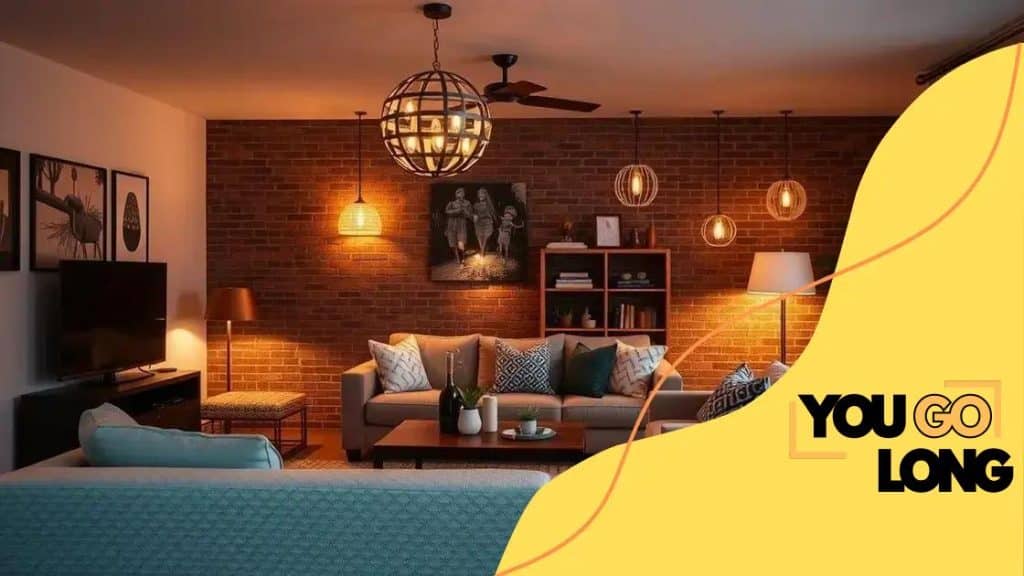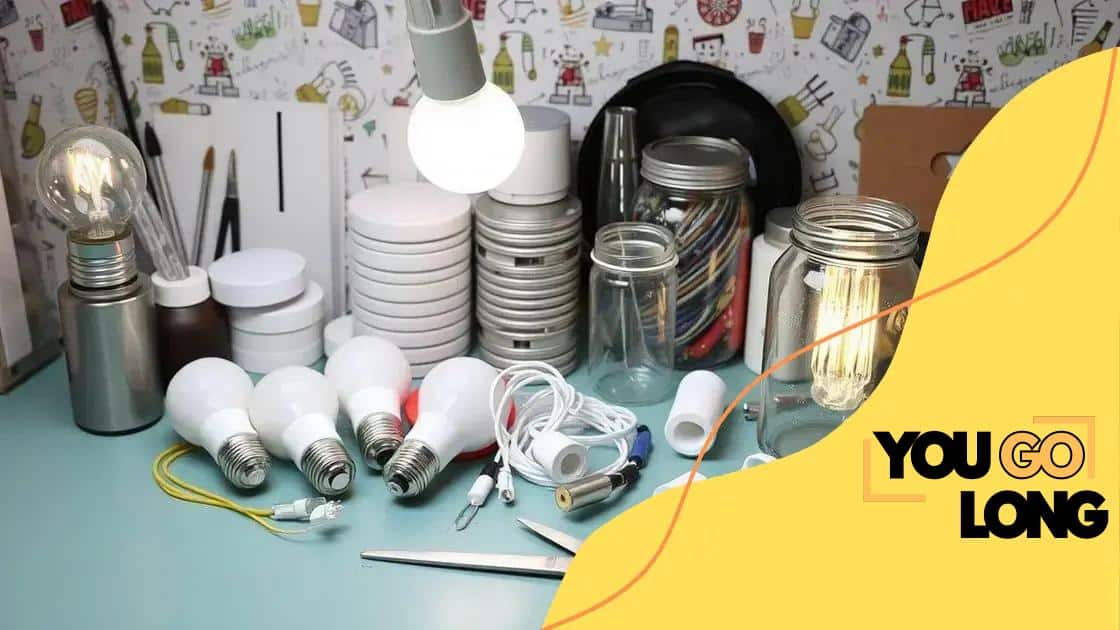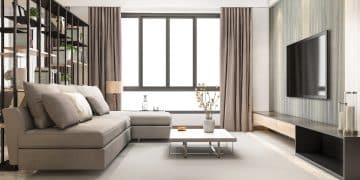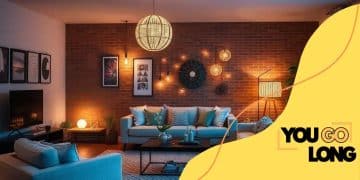DIY lighting projects to brighten up your space

Advertisement
DIY lighting projects can elevate your space by using materials like bulbs and sockets creatively, layering different light types, and choosing the right color temperature to achieve the perfect ambiance.
DIY lighting projects to brighten up your space can be a game changer for any room. Have you ever thought about how the right lighting affects your mood and decor? Let’s explore some fun and creative projects that can easily enhance your environment.
Understanding the impact of lighting in your home
Understanding the impact of lighting in your home can truly transform your living spaces. Lighting does more than just illuminate; it influences our mood, productivity, and overall ambiance. The right lighting can make a small room feel larger or create a cozy nook for relaxation.
The Emotional Effects of Lighting
Consider how different types of lighting can affect your emotions. For instance, natural light is known to boost our spirits, while low lighting can create a calming atmosphere. You can play with various lighting styles to evoke the feelings you want in each room.
Advertisement
- Bright, white light is ideal for kitchens and workspaces, enhancing focus.
- Soft, warm lighting works well in living areas, promoting relaxation.
- Accent lighting can highlight artwork and create points of interest.
Beyond emotions, consider how lighting impacts everyday activities. Bright light can improve concentration, making it important in home offices. Conversely, dim lights may be preferred in bedrooms for winding down after a long day.
Practical Tips for Lighting Design
When designing your lighting scheme, keep functionality in mind. Layering different types of lighting—ambient, task, and accent—can create a well-balanced and inviting environment.
- Use ambient lighting for overall illumination, such as ceiling fixtures.
- Add task lighting where you need focused light, such as beside a reading chair.
- Incorporate accent lighting to draw attention to specific decor elements.
Experimenting with DIY lighting projects can also lead to custom solutions tailored to your needs. For example, adjustable light fixtures can put you in control of the ambiance. Remember, the goal is not just to light a room, but to enhance its overall function and aesthetic.
Advertisement
Simple DIY lighting ideas for every room
Simple DIY lighting ideas for every room can elevate your home’s style while keeping it functional. Lighting projects are not only fun but also a great way to add a personal touch to your space. With just a few supplies, you can create unique fixtures that brighten up any area.
Creative Lighting Solutions
One popular idea is to make a pendant light using a simple basket. This project allows you to customize the look based on your decor. Just hang the basket from the ceiling, add a light bulb inside, and enjoy the warmth it brings to your room.
- Use colorful fabric to cover a plain lampshade for a fresh look.
- Repurpose old jars as charming wall sconces by adding lights inside them.
- Create a unique lighting focal point using fairy lights in a glass vase.
Consider using string lights to add a festive feel. Hang them above your bed or along a bookshelf for an enchanting glow. They are simple to install and can be easily changed depending on the season or your mood.
Lighting for Specific Rooms
Different rooms call for different lighting solutions. In the kitchen, bright lights are key. Using under-cabinet lights can enhance visibility while cooking. In bedrooms, a softer glow creates a relaxing atmosphere.
- In the living room, floor lamps with adjustable heads can provide both task and ambient lighting.
- Children’s rooms can be fun with lighting shapes, like stars or animals, adding a playful touch.
- In the home office, desk lamps with adjustable brightness can help reduce eye strain.
Don’t forget about the bathroom! A simple DIY mirror frame with built-in lights can brighten up that space wonderfully. Small projects like these can make your home more inviting and personalized.
Materials you need for DIY lighting projects

When undertaking DIY lighting projects, selecting the right materials is essential for success. Understanding what supplies you need can make the process smoother and more enjoyable. With a few basic items, you can create stunning lighting that personalizes your space.
Essential Tools and Supplies
First, gather some basic tools. Common items like a drill, screwdriver, and scissors can help you shape and install your lighting fixtures. Having these tools ready will save you time and frustration.
For materials, you can use components like wires, sockets, and light bulbs. These supplies are crucial for creating functional and safe lighting.
- Bulbs: Consider LED bulbs for energy efficiency.
- Wire: Use electrical wire to connect your light fixtures.
- Socket: Light sockets hold the bulbs securely.
Next, think about the decorative aspects of your projects. Items such as jars, baskets, and wooden boards can enhance the style of your lighting. For example, a glass jar can turn into a lovely pendant light when combined with a bulb and wire. Don’t hesitate to get creative with materials you already have at home!
Safety Gear
Safety is paramount when working on electrical projects. Always wear protective gear, such as gloves and goggles, to prevent injuries.
Before you start, be sure to turn off the power at the circuit breaker. This ensures that you can work safely with your lighting project without any risk.
- Gloves: Protect your hands while handling tools.
- Goggles: Keep your eyes safe from debris.
- Electrical tape: Secure any connections for safety.
Having the right materials and following safety precautions will guide you toward successful DIY lighting projects. Remember, it’s all about making your space shine!
Creative ways to hang and display lights
Creative ways to hang and display lights can dramatically change the atmosphere of your home. Instead of traditional fixtures, think outside the box to showcase your lights in unique styles. With just a bit of imagination, you can create beautiful lighting features that enhance your space.
Using Everyday Items
One way to display lights creatively is by repurposing everyday items. Consider using ladder shelves to hang string lights. This creates a rustic look while also providing a great way to display books or plants. You can easily add warm lights to enhance the ambiance.
- Old windows can be transformed into a charming light display with fairy lights.
- Hangers can be repurposed to hold string lights in a fun and artistic way.
- Bucket lights can bring an industrial vibe to any room.
You can even use wooden dowels or branches to create an organic, nature-inspired light installation. Hang lights from these materials for a whimsical effect that draws the eye.
Highlighting Artwork and Features
Another great method is to use lighting to highlight artwork or architectural details. Installing lights above a painting or sculpture can add depth and focus. Use track lighting or spotlights to draw attention to the pieces you love the most.
- Picture lights can enhance family photos or special artwork.
- Accent lights can fill dark corners and create cozy seating areas.
- Use recessed lighting to keep the focus on your decor without bulky fixtures.
Don’t forget about outdoor spaces! String lights around patios or drape them over fences to create an inviting atmosphere for outdoor gatherings. Whether indoors or outside, innovative lighting displays can transform any area into your personal oasis.
Tips for achieving the perfect ambiance
Tips for achieving the perfect ambiance can greatly enhance your living spaces. The right lighting can transform any room into a welcoming retreat. Whether you want a cozy atmosphere or a lively gathering spot, adjusting your lights is key to achieving those vibes.
Layering Your Lighting
One effective method is to use layering when planning your lighting. This involves using a combination of ambient, task, and accent lighting to create a well-balanced scene. Ambient lighting provides the overall illumination, while task lighting focuses on specific areas, such as reading corners or kitchen countertops.
- Choose floor lamps or overhead lights for ambient lighting.
- Use table lamps for task lighting in workspaces.
- Highlight artworks with accent lights to draw attention.
By layering these different types, you can easily adjust the feel of each room based on the occasion or your mood.
Color Temperature Matters
The color temperature of your bulbs also plays a significant role in setting the mood. For a warm and inviting feel, opt for bulbs that emit a warm white light. This type of light is perfect for living rooms and bedrooms. In contrast, cooler white light is better suited for workspaces, as it helps improve focus and energy.
- Choose 2700K-3000K for warm, cozy environments.
- Use 4000K-5000K for bright, stimulating lights in kitchens and offices.
- Consider dimmable bulbs for versatility in changing the ambiance.
Remember, soft lighting with dimmers can create a gentle atmosphere ideal for evening relaxation.
Creating Focal Points
Another way to enhance ambiance is by creating focal points in your room. These can be achieved through unique light fixtures or strategically placed lamps. For instance, a beautiful chandelier can serve as a great centerpiece in a dining room, while a striking floor lamp can bring a stylish element to a reading nook. Focus the light on these areas to make them stand out and draw the eye.
By experimenting with different setups and combinations, you can find what works best for your space. Achieving the perfect ambiance is about balancing light, color, and purpose. Let your creativity shine through!
In conclusion, creating the perfect lighting in your home can truly elevate your living experience. By choosing the right materials, employing creative techniques for hanging and displaying lights, and understanding how to achieve the ideal ambiance, you can transform any space into a warm and inviting environment. Remember to experiment with layers of light and consider the color temperature of your bulbs to find what works best for you. With these tips, you’ll be well on your way to brightening up your space with style!
FAQ – Frequently Asked Questions about DIY Lighting Projects
What are the best materials for DIY lighting projects?
Basic materials include light bulbs, sockets, electrical wire, and decorative items like jars or baskets.
How can I create the perfect ambiance with lighting?
Use a combination of ambient, task, and accent lighting, and choose warm color temperatures for cozy spaces.
What creative ways can I hang and display lights?
Repurpose everyday items like ladders or old windows, and create focal points with unique fixtures to enhance your decor.
How important is safety when doing DIY lighting?
Safety is crucial; always use protective gear, turn off power at the circuit breaker, and secure connections with electrical tape.





